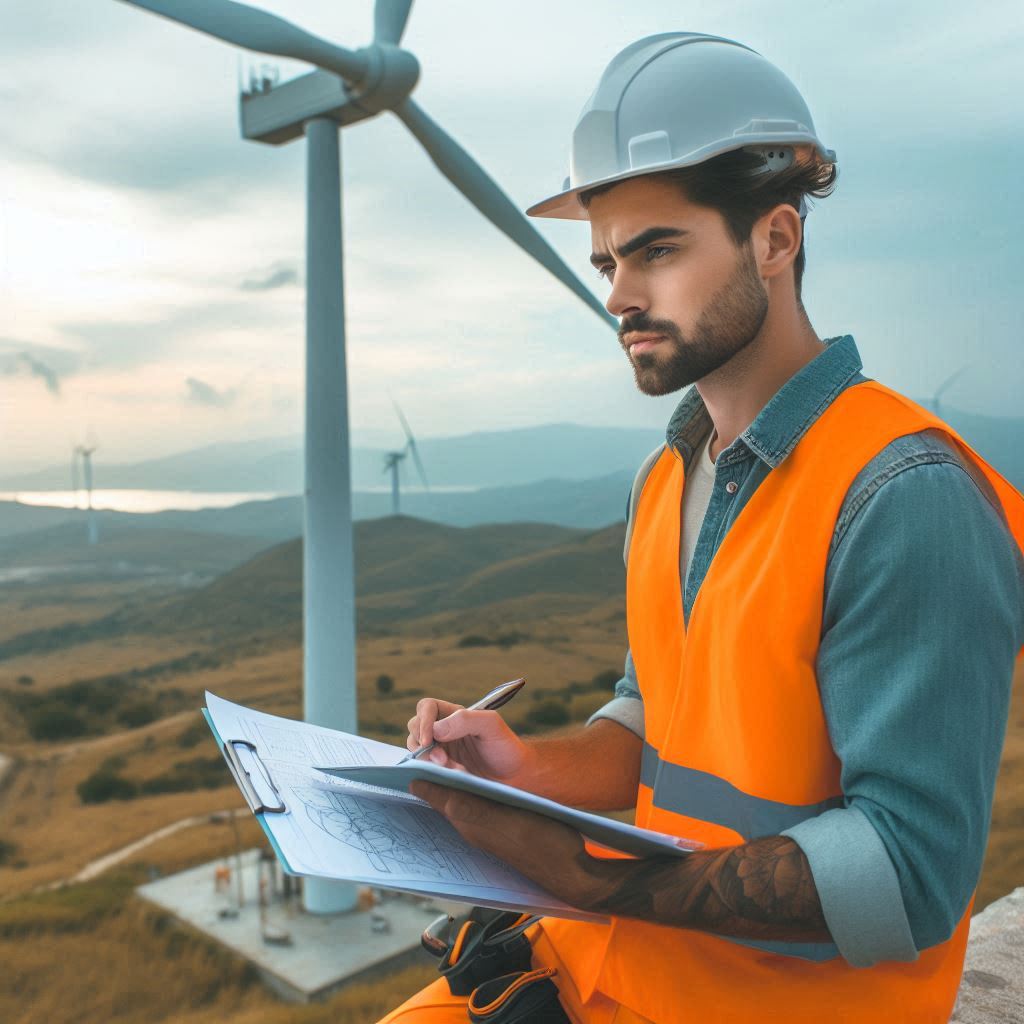Introduction
Wind turbine technicians are vital to the renewable energy sector.
They play a crucial role in ensuring that wind turbines operate efficiently and safely.
These technicians are responsible for maintaining, repairing, and troubleshooting complex turbine systems, which is essential for maximizing energy production and maintaining operational reliability.
Their work supports the overall effectiveness of wind farms and contributes significantly to the growth of wind energy.
With the increasing emphasis on renewable energy, the demand for skilled wind turbine technicians is rising.
The global shift towards wind energy has led to a substantial increase in the number of wind farms and turbines being installed.
As wind energy becomes a more prominent part of the energy mix, the need for trained professionals to handle advanced turbine technologies and ensure their proper functioning grows.
As more wind farms are developed, technicians are required to manage increasingly complex turbine systems.
These systems often incorporate advanced electronics, sophisticated control systems, and larger turbine components.
This complexity necessitates a higher level of skill and knowledge from technicians.
The growing demand for wind turbine technicians reflects the sector’s expansion and the need for expertise to maintain and enhance wind energy production.
Lack of formal education and training
Challenge of Finding Qualified Individuals with the Necessary Technical Knowledge
Finding qualified wind turbine technicians with the necessary technical knowledge presents a significant challenge.
The wind energy sector requires highly specialized skills and expertise.
Technicians need a deep understanding of turbine systems, electrical components, and mechanical processes.
The complexity of wind turbines demands extensive technical training and experience.
Many job postings struggle to attract candidates with the right qualifications.
This skills gap can delay maintenance and repair work.
Employers face difficulties in finding individuals who meet both technical and safety standards.
The shortage of skilled technicians can also impact the efficiency of wind energy operations.
Importance of Specialized Training Programs for Wind Turbine Technicians
Specialized training programs are crucial in addressing the skills gap in the wind energy sector.
These programs provide targeted education in wind turbine technology and maintenance.
Training includes hands-on experience with turbine systems and safety procedures.
Specialized courses cover electrical systems, mechanical components, and troubleshooting techniques.
They equip technicians with the practical skills needed to handle complex turbine issues.
These programs also stay updated with industry advancements and new technologies.
By completing specialized training, technicians become proficient in the latest wind turbine technologies.
This expertise helps bridge the gap between available talent and industry needs.
Effective training programs also enhance job readiness and career prospects for graduates.
Basically, finding qualified wind turbine technicians with the necessary technical knowledge is a significant challenge.
The complexity of turbines requires specialized skills that are often in short supply.
Specialized training programs are essential in developing these skills and addressing the skills gap.
They provide targeted education and hands-on experience, ensuring technicians are well-prepared for the demands of the wind energy sector.
Safety Concerns
Working at great heights and in potentially hazardous conditions
Working as a wind turbine technician comes with its fair share of safety concerns that must be addressed to prevent accidents and ensure the well-being of the technicians.
One of the primary risks involved in this line of work is working at great heights.
Wind turbines are often located in remote or elevated locations, necessitating technicians to ascend to significant heights to conduct maintenance and repairs.
This height presents a real danger of falls and injuries if proper precautions are not taken.
In addition to the risks associated with working at great heights, technicians also face potentially hazardous conditions while performing their duties.
Wind turbines are exposed to various weather elements, including strong winds, rain, snow, and lightning.
These conditions can pose serious risks to technicians working on the turbines, making it essential for them to be vigilant and prepared for any eventuality.
Importance of Following Strict Safety Protocols
- Strict safety protocols are crucial to preventing accidents and injuries.
- Following safety guidelines ensures the well-being of technicians and others on-site.
Given the risks involved in working as a wind turbine technician, following strict safety protocols is non-negotiable.
Safety protocols are in place to protect technicians from harm and prevent accidents that could result in serious injuries or fatalities.
By adhering to these protocols, technicians can reduce the likelihood of accidents and create a safe working environment for themselves and their colleagues.
Furthermore, following safety guidelines not only safeguards the well-being of technicians but also ensures the safety of others on-site.
Wind turbine maintenance often involves working in teams, with technicians relying on each other for support and assistance.
By following safety protocols, technicians can contribute to a culture of safety that benefits everyone involved in the maintenance and operation of wind turbines.
Exposure to harsh weather conditions
Working in extreme weather conditions, such as high winds and low temperatures, poses a significant challenge for wind turbine technicians.
These conditions can have a direct impact on the maintenance and repair of wind turbines, making the technicians’ job more difficult and dangerous.
Challenges of working in extreme weather conditions
- High winds: Wind turbine technicians must work at great heights to repair and maintain the turbines, making them vulnerable to strong winds that can make it difficult to move around safely.
- Low temperatures: Cold weather can affect the performance of equipment and tools, making it challenging for technicians to complete their tasks efficiently.
- Snow and ice: In winter, snow and ice can accumulate on the turbines, creating slippery and hazardous conditions for technicians working at height.
- Storms: Severe weather events such as thunderstorms and hurricanes can pose a threat to the safety of technicians working on wind turbines, requiring them to take extra precautions.
Impact of weather on maintenance and repair
- Reduced productivity: Harsh weather conditions can slow down the maintenance and repair process, leading to delays in fixing issues with the turbines.
- Safety risks: Working in extreme weather conditions increases the risk of accidents and injuries for technicians, who must navigate challenging conditions while performing their tasks.
- Equipment performance: Cold temperatures can affect the performance of tools and equipment, making it harder for technicians to complete their work effectively.
- Downtime: Adverse weather conditions can result in downtime for wind turbines, affecting their overall efficiency and energy production.
In review, exposure to harsh weather conditions is a common challenge for wind turbine technicians that can impact their safety, productivity, and the performance of the turbines.
It is essential for technicians to be well-prepared and equipped to handle these challenges effectively in order to ensure the reliable operation of wind energy systems.
Read: Continuing Education for Radiologic Technologists
Limited access to remote locations
Challenge of Reaching Wind Turbine Sites Located in Remote or Offshore Areas
Wind turbine technicians face significant challenges when reaching sites located in remote or offshore areas.
Accessing these locations often requires specialized transportation and planning.
Remote wind farms may be situated in areas with limited infrastructure, making travel difficult.
Technicians must navigate rugged terrain or adverse weather conditions to reach these sites.
Offshore wind farms present additional challenges.
Technicians need to travel by boat or helicopter, which can be subject to weather conditions.
Safety considerations are paramount, requiring technicians to use appropriate safety gear and follow strict protocols.
The distance and complexity of reaching these sites can lead to extended travel times, impacting the efficiency of maintenance and repair operations.
Logistics Involved in Transporting Technicians and Equipment to These Locations
Transporting technicians and equipment to remote or offshore wind turbine sites involves complex logistics.
For remote locations, technicians often use off-road vehicles, such as trucks or all-terrain vehicles.
These vehicles must be equipped to handle rough terrain and carry necessary tools and spare parts.
Offshore sites require different logistical approaches.
Boats or ships are commonly used to transport technicians and equipment.
These vessels must be properly equipped with safety features and be able to handle the specific demands of offshore environments.
Scheduling and coordination are crucial, as weather conditions can affect transportation schedules and safety.
The logistics also include ensuring that all equipment is transported safely and securely.
Technicians need specialized tools and parts, which must be carefully packed and secured during transport.
Any delays or issues with equipment delivery can significantly impact the maintenance and repair timelines.
Additionally, coordinating travel and accommodation for technicians can be challenging.
For remote sites, technicians may need to stay in temporary accommodations, such as mobile camps or nearby facilities.
Offshore technicians often work on rotation schedules, requiring careful planning to manage shifts and ensure continuous operations.
Read: Common Mistakes in Quality Control Inspections

Technological advancements
The challenge of Keeping Up with Rapidly Evolving Wind Turbine Technology
Wind turbine technicians face the significant challenge of keeping up with rapidly evolving wind turbine technology.
Modern wind turbines integrate advanced electronics, sophisticated control systems, and cutting-edge materials.
These technological advancements enhance turbine efficiency and performance but also increase the complexity of maintenance and repair tasks.
As new models and components are introduced, each with unique features, technicians must adapt quickly to manage these innovations effectively.
The pace of technological change is swift, making it crucial for technicians to stay updated on the latest developments.
Failure to do so can hinder their ability to diagnose and repair complex issues accurately, impacting overall turbine performance and reliability.
Need for Ongoing Training and Professional Development to Stay Current with Industry Trends
To address the challenge of evolving technology, ongoing training and professional development are essential.
Many organizations offer specialized courses that focus on the latest turbine technologies and practices.
These courses provide technicians with the skills needed to handle new systems and tools.
Practical, hands-on experience with modern equipment is crucial for mastering new technologies.
Attending industry conferences and workshops also helps technicians stay informed about emerging trends and innovations.
Additionally, industry certifications often require continuing education to maintain credentials, ensuring that technicians remain knowledgeable about current technologies and industry standards.
Subscribing to industry publications and joining professional associations can offer valuable updates and networking opportunities.
Employers play a crucial role by providing internal training programs and encouraging additional certifications.
Investing in employee development helps technicians manage evolving technology effectively and maintain high performance.
This commitment to learning is vital for maintaining the efficiency and reliability of wind energy systems and supporting the growth of the renewable energy sector.
Read: Best Online Courses for CAD Technician Training
Work-life balance
Addressing Irregular Work Schedules and Long Hours for Wind Turbine Technicians
Wind turbine technicians often face irregular work schedules and long hours.
The nature of wind energy requires round-the-clock monitoring and maintenance.
Technicians may need to work evenings, weekends, and holidays.
This irregularity can disrupt personal routines and family life.
Long hours are common due to the urgent nature of repairs and preventive maintenance.
Extended shifts can lead to physical and mental fatigue.
Technicians must be prepared for these demanding schedules as part of their job.
Flexibility and resilience are essential traits for managing these challenges effectively.
Adapting to changing work hours while maintaining high performance is crucial for success in this role.
Importance of Managing Workload and Prioritizing Self-Care to Prevent Burnout
Managing workload and prioritizing self-care are vital to prevent burnout.
Technicians must balance their work demands with personal well-being.
Proper time management helps in handling extended hours and irregular shifts.
Technicians should set boundaries between work and personal life to avoid overwork.
Regular breaks and adequate rest are important for maintaining energy levels.
Engaging in hobbies and activities outside of work can reduce stress.
Mental health support and counseling services may also be beneficial.
Technicians should communicate with their employers about workload concerns and seek adjustments when needed.
Prioritizing self-care ensures long-term productivity and job satisfaction.
In essence, wind turbine technicians face challenges with irregular work schedules and long hours.
Managing these demands effectively requires flexibility and resilience.
Balancing workload with self-care practices is crucial to prevent burnout.
By prioritizing rest, setting boundaries, and seeking support, technicians can maintain their well-being and performance.
Addressing these challenges ensures a sustainable and fulfilling career in the wind energy sector.
Read: CAD Technician Job Market: Trends and Insights
Transform Your Career Today
Unlock a personalized career strategy that drives real results. Get tailored advice and a roadmap designed just for you.
Start NowEquipment Maintenance and Repair
Challenge of Troubleshooting and Fixing Complex Mechanical and Electrical Issues
Wind turbine technicians frequently face the challenge of troubleshooting and fixing complex mechanical and electrical issues.
Wind turbines are intricate machines with various components that can malfunction.
Technicians must identify and diagnose problems in systems involving gears, motors, and electronics.
These issues often require a deep understanding of both mechanical and electrical systems to resolve effectively.
Mechanical problems might include gearbox failures or blade malfunctions, while electrical issues could involve control systems or wiring faults.
Diagnosing these issues requires specialized skills and tools.
Technicians must use diagnostic equipment to pinpoint faults accurately.
Complex problems can be time-consuming and challenging, requiring persistence and expertise.
Moreover, troubleshooting can be complicated by the remote locations of many wind turbines.
Technicians may need to work at great heights or in harsh weather conditions.
This adds to the difficulty of diagnosing and repairing issues.
The need for precision and safety is paramount when working on such complex machinery.
Importance of Having a Strong Knowledge of Turbine Components and Systems
A strong knowledge of turbine components and systems is crucial for addressing these challenges effectively.
Wind turbines consist of numerous parts, including generators, gearboxes, and control systems.
Technicians must understand how these components interact and function together.
Knowledge of turbine systems helps technicians quickly identify the source of problems.
Understanding the role of each component enables more accurate diagnostics and efficient repairs.
Technicians with a comprehensive knowledge base can troubleshoot issues more effectively and implement solutions that ensure turbine reliability.
Additionally, familiarity with turbine components and systems supports preventive maintenance efforts.
Technicians can anticipate potential issues and perform regular checks to prevent major breakdowns.
This proactive approach reduces downtime and enhances turbine performance.
Understanding turbine systems also aids in adapting to new technologies.
Wind turbines are continually evolving, with advancements in components and control systems.
Technicians who stay updated on technological changes can more easily manage and repair newer turbine models.
Learn More: Top Radiologic Technologist Schools in the USA
Learn More: Impact of Cyber Threats on Cybersecurity Analyst Jobs
Delve into the Subject: Why Network Engineers Are Essential for Businesses
Find Out More: How to Lead a Successful Systems Engineering Team
Career advancement opportunities
Limited career growth prospects for wind turbine technicians
Wind turbine technicians often face limited career growth prospects within their role.
While the job can be rewarding in the short term, many technicians find themselves looking for ways to advance within the industry.
Here are some potential pathways for advancing in the renewable energy sector
Specializing in a specific area
- By specializing in a specific aspect of wind turbine technology, technicians can become experts in their field.
This could involve focusing on a particular type of turbine, such as offshore turbines, or on a specific component, like gearbox maintenance. - Specializing can open up new opportunities for career progression, as companies value employees with in-depth knowledge and skills.
It also allows technicians to command higher salaries and take on more challenging projects.
Pursuing further education
- Another way for wind turbine technicians to advance in their careers is by pursuing further education.
This could involve obtaining additional certifications or degrees related to renewable energy or engineering. - Advanced education can help technicians develop a deeper understanding of wind energy systems and technologies.
It can also demonstrate a commitment to professional development, making technicians more attractive to employers seeking candidates for higher-level positions.
Ultimately, while career advancement opportunities may be limited for wind turbine technicians within their current roles.
There are several pathways available for those looking to progress in the renewable energy industry.
By specializing in a specific area or pursuing further education, technicians can enhance their skills.
Increase their earning potential, and take on more challenging and rewarding roles.
Conclusion
Wind turbine technicians encounter several significant challenges that impact their daily work.
Harsh weather conditions, including extreme temperatures and high winds, can make maintenance and repair tasks particularly demanding.
The complexity of modern turbine systems requires technicians to have a deep understanding of both mechanical and electrical components.
Working at great heights and in often remote or inaccessible locations adds additional layers of difficulty and risk.
Safety is a paramount concern, with the need for stringent protocols and personal protective equipment to mitigate hazards.
Technicians also face the challenge of staying current with rapidly evolving technologies and industry standards, necessitating continuous training and skill development.
Addressing these challenges is crucial for maintaining a skilled and effective workforce.
Comprehensive training programs and robust safety measures can help technicians navigate these obstacles more effectively.
Investing in advanced tools and technologies can streamline complex tasks and enhance overall efficiency.
By tackling these issues, technicians ensure the reliable operation and longevity of wind turbines, which is vital for the growth and sustainability of the renewable energy sector.
A well-prepared workforce is essential to meet the increasing energy demands and support the continued expansion of clean energy.
[E-Books for Sale]
The Big Book of 500 High-Paying Jobs in America: Unlock Your Earning Potential
$19.99 • 500 High-Paying Jobs • 330 pages
Explore 500 high-paying jobs in America and learn how to boost your career, earn more, and achieve success!
See All 500 High-Paying Jobs of this E-Book
1001 Professions Without a Degree: High-Paying American Jobs You Can Start Now
$19.99 • 1001 Professions Without a Degree • 174 pages
Discover 1001 high-paying jobs without a degree! Unlock career tips, skills, and success strategies for just $19.99!




